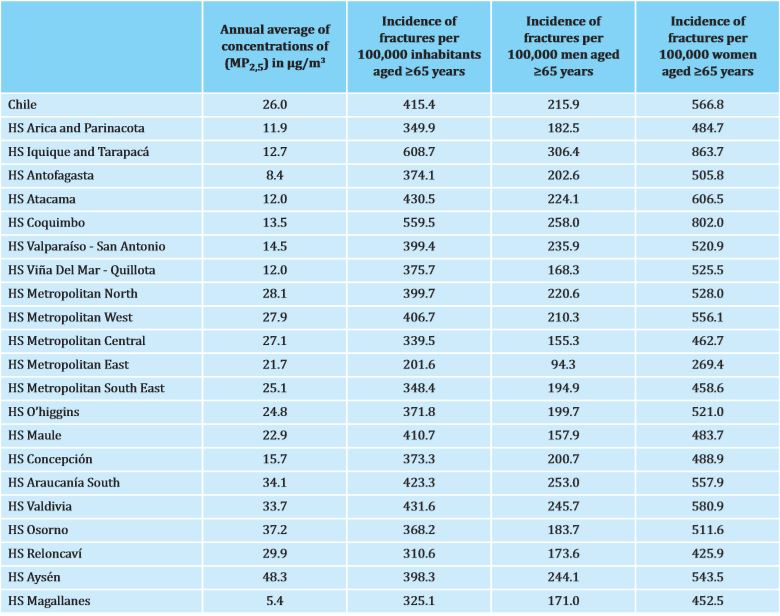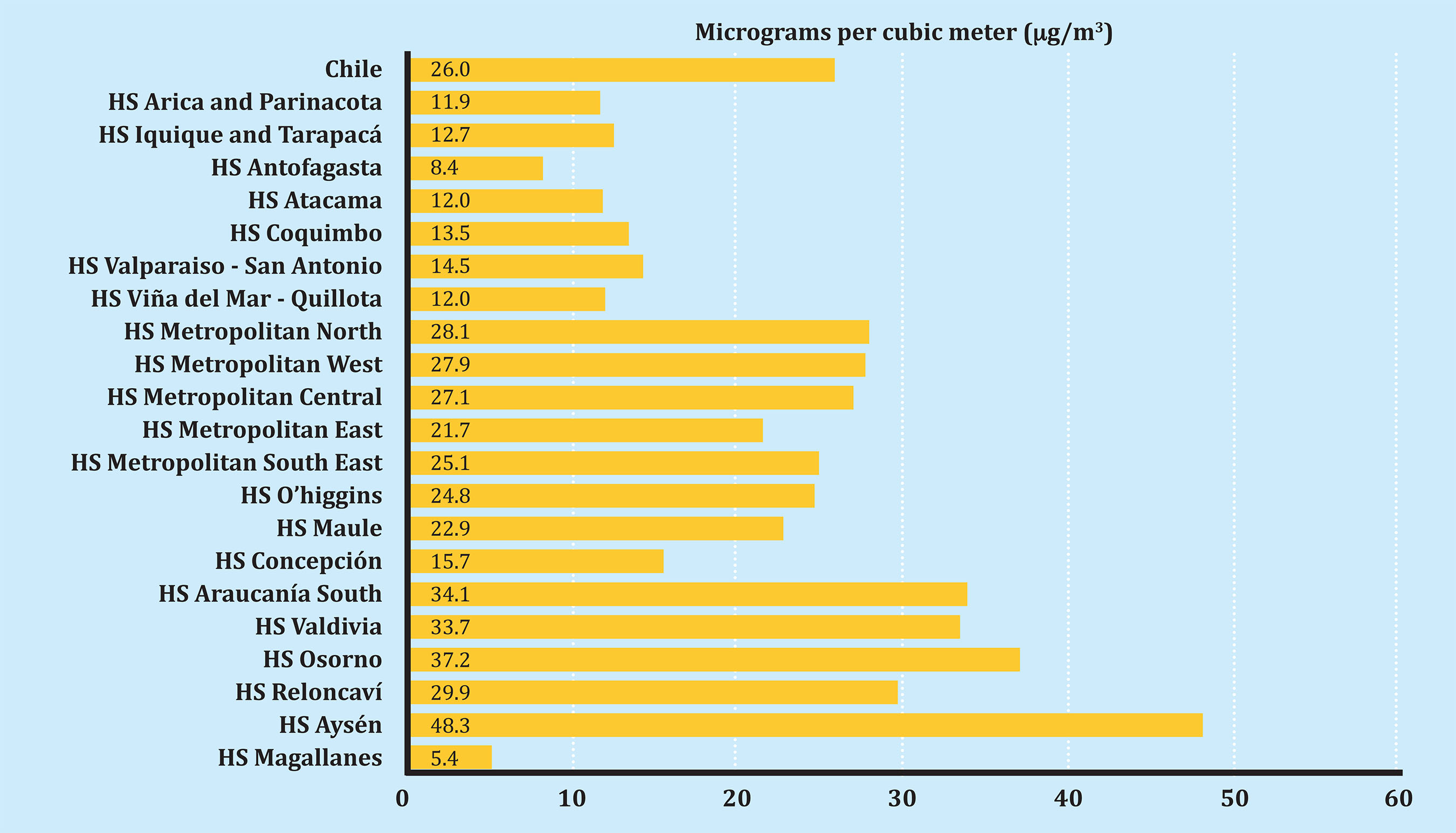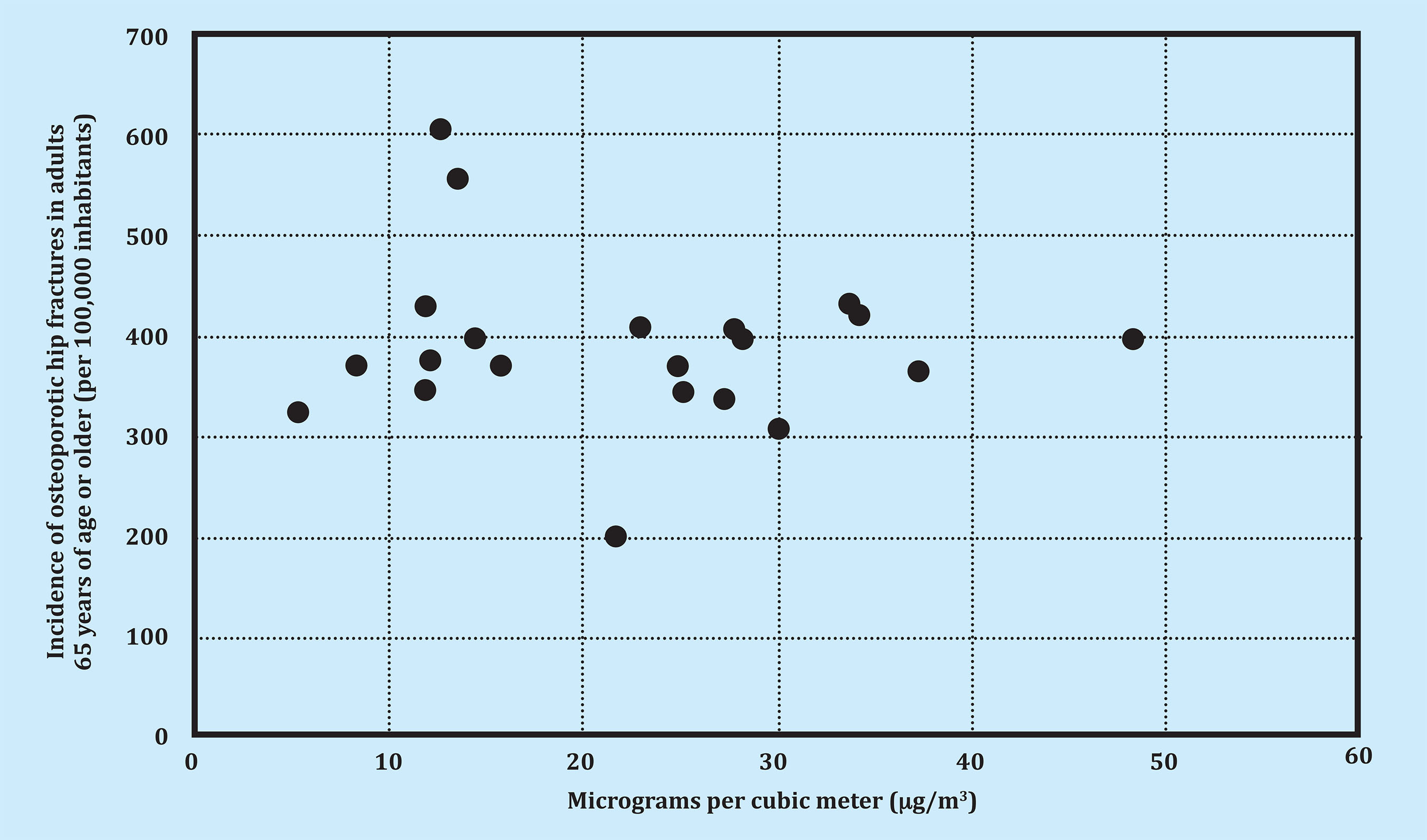Mi SciELO
Servicios Personalizados
Revista
Articulo
Indicadores
-
 Citado por SciELO
Citado por SciELO -
 Accesos
Accesos
Links relacionados
-
 Citado por Google
Citado por Google -
 Similares en
SciELO
Similares en
SciELO -
 Similares en Google
Similares en Google
Compartir
Revista de Osteoporosis y Metabolismo Mineral
versión On-line ISSN 2173-2345versión impresa ISSN 1889-836X
Rev Osteoporos Metab Miner vol.11 no.4 Madrid nov./dic. 2019 Epub 06-Abr-2020
https://dx.doi.org/10.4321/s1889-836x2019000400002
ORIGINALS
Air quality and incidence of osteoporotic hip fracture in Chile
1Faculty of Medicine. University of Concepción. Concepción (Chile).
2Endocrinology Section. Department of Internal Medicine. School of Medicine. University of Concepción. Concepción (Chile).
Objetive:
Recent studies show an association between environmental pollution and the risk of suffering an osteoporotic fracture. This study aimed to determine if there is an association between environmental contamination with fine particulate matter (PM2.5) and osteoporotic hip fracture.
Material and method:
Retrospective incidence study. The Pearson correlation coefficient (r) was used to assess the correlation between the incidence rate of hospital discharges due to osteoporotic hip fracture in Chile and the annual average concentration of PM2.5in the Chilean Health Services in 2017.
Results:
In 2017 there were 8,322 hip fractures in adults 65 years of age or older, with a rate per 100,000 inhabitants of 216 and 567 for men and women, respectively. No association was found between environmental contamination and hip fractures in women. Very weak direct association was found between the incidence rate of osteoporotic hip fracture in men and the annual concentration of PM2.5(r=0.074) by Health Services, being statistically not significant (p>0.05)
Conclusions:
No statistically significant association was found between environmental pollution and the incidence rate of hospital discharges due to osteoporotic hip fractures in Chile.
Key words: environmental pollution; particulate matter; osteoporosis; hip
INTRODUCTION
Environmental pollution has been associated with a variety of diseases. Among these conditions, cardiovascular1and respiratory2have been highlighted in the literature.
Air quality monitoring has preferably been oriented to particulate matter. These particles are mainly found in urban areas and come from thermal power plants, industrial processes, vehicle traffic, residential combustion of wood for heating, coal and industrial incinerators. Particulate matter (PM) is classified according to its diameter, depending on the intensity of its impact: particles of diameter less than 10 µg, known as PM10, and diameters less than 2.5 µg, known as PM2.5. The PM2.5particles, having a smaller diameter, penetrate into the pulmonary alveoli and enter directly into the bloodstream. This makes them the most harmful contaminant for health and the ones that generate higher levels of premature mortality in the population, ranking as the fifth mortality risk factor in 20153. Exposure to higher concentrations of PM2.5caused 4.2 million deaths and 103 million lost healthy life years (AVISA) worldwide in 2015, representing 7, 6% of total deaths and 4.2% of AVISA3. Worldwide deaths attributable to PM2.5increased from 3.5 million in 1990 to 4.2 million in 20153.
Environmental pollution has been associated with a variety of diseases, especially those related to diseases of the skeletal muscle system, particulate matter is associated with oxidative damage and inflammation, which can accelerate bone loss and increase the risk of fractures in older adults Studies in Norway show a higher risk of developing osteoporosis and suffering an osteoporotic fracture in the population exposed to higher concentrations of PM2.54,5. Recent studies in the US show that for every 4.18 μg/m3increase in PM2.5there is a 4.1% increase in hospital admissions for bone fractures in older adults. Low concentrations of parathyroid hormone in blood are associated with individuals who live in areas of higher PM2.5concentration6.
In Chile, PM2.5and other air quality variables are measured daily at air quality monitoring stations. In 2017, of the 31 monitoring stations with population representativeness (representing more than 10 million inhabitants of the 17.5 million inhabitants in Chile), 22 of them (69% of the total) presented concentrations above the value of the annual primary standard for PM2.5(20 µg/m3)7. That same year, more than 8 million inhabitants of Chile (figures close to 50% of the population) were exposed to average concentrations of PM2.5higher than the norm. In Chile"s central zone, where there are more than 7 million inhabitants, the average concentrations of PM2.5reach 29 µg/m3. Toward southern Chile, the concentrations increase considerably. The city of Coyhaique, which has about 61 thousand inhabitants, is the most polluted city in Latin America, exposed to the highest average PM2.5concentrations (57 µg/m3)7.
The only study in Latin America that evaluates the association between air pollution and osteoporosis was carried out in Chile, analyzing the association between hospital discharges from 2005 to 2011 and the particulate matter. No statistically significant association was found between air pollution and the average annual incidence of osteoporotic hip fracture in Chile. However, data from some cities were used and not data corresponding to the Chilean Health Services, so a large number of hospital discharges were left out of the study8.
The aim of this study was to determine if there is an association between air pollution and osteoporotic hip fracture in the Chilean population.
MATERIAL AND METHOD
A retrospective incidence study was conducted.
The National Health Services System (NHSS) of Chile has 29 territorial Health Services (HS) that encoPMass defined geographical territories.
The Ministry of Health"s Department of Health Statistics and Information (DHSI) 2017 records were used, from which the amount of osteoporotic hip fractures was obtained for each Chilean HS. The hip fractures correspond to the S72 code of the ICD-10 (tenth edition of the International Classification of Diseases), and hip fractures corresponding to adults 65 years of age or older were used, as these are attributed to osteoporosis.
From the records of the National Institute of Statistics (NIS), the data of the population of 65 years and over by HS were obtained in 2017. The HS data of the number of inhabitants of 65 years or more were used and the number of hip fractures in adults 65 years of age or older by HS to calculate the incidence of osteoporotic hip fracture in each HS.
Data from the National Air Quality Information System (SINCA) were used to obtain the annual average concentration of PM2.5(in μg/m3) in each SS. Because not all health services have PM2.5monitoring stations or do not have validated records for 2017, 8 of the 29 HS of Chile were excluded, which means approximately 3 million of the country"s inhabitants (17% of the total Chilean population).
With the statistical package SPSS 21.0, Pearson's correlation coefficient was measured (test used to measure the degree of relationship of two linearly related quantitative variables) to assess the association between the annual incidence of osteoporotic hip fracture by HS and the annual average of concentration of PM2.5per HS in 21 of the 29 Chilean HS (representing approximately 14.5 of the 17.5 million inhabitants of the country, 83% of this). A 95% confidence level was used, so the results with p<0.05 are considered significant. When interpreting the level of correlation, a value r=1, a very strong correlation 1>r>0.8, a strong correlation with 0.8>r>0.6, a moderate correlation with 0, is considered a perfect correlation. 6>r>0.4, a weak correlation with r 0.4>r>0.2, a very weak correlation with 0.2>r>0, and a null correlation with r=0.
The study has its limitations. It is retrospective and does not assess the health habits of the population evaluated. However, by including most of the HS in Chile, it uses a large part of the population and by including only the 2017 data, it does not present the bias of including population that changed direction in the evaluated years.
RESULTS
In 2017, 8,322 osteoporotic hip fractures occurred in Chile for an estimated population of 17.5 million, according to the 2017 Census. The national incidence rate of osteoporotic hip fractures was 415.4 per 100,000 adults of 65 or older, being lower for men (215.9 per 100,000 men 65 or older) and higher for women (566.8 per 100,000 women 65 or older). The HS with the highest incidence of osteoporotic hip fractures is the HS of Iquique and Tarapacá, while the HS with the lowest incidence is the Eastern Metropolitan Area (Table 1).
Table 1. Annual average of concentrations of fine particulate material PM2.5and incidence of hip fractures in adults 65 years of age or older in each Health Service (HS) during 2017

In terms of air quality, this was evaluated with annual concentrations of PM2.5in each HS. The annual primary standard for PM2.5is 20 μg/m3. Of the 21 HS evaluated, 12 were exposed to average annual concentrations above the norm. The Aysén HS, with approximately 110,000 inhabitants, is the HS exposed to the highest annual average concentrations of PM2.5(48.3 μg/m3); while the Magallanes HS, with approximately 161,000 inhabitants, is the HS with the lowest annual average concentrations of PM2.5(5.4 μg/m3) (Figure 1).

Figure 1. Annual average concentrations of fine particulate material (PM2.5) in the Health Services of Chile in 2017
Regarding the association between the annual average concentration of PM2.5and annual incidence rate of osteoporotic hip fractures by HS, analyzing in men, women and in both sexes, no association was found between the variables, since the coefficient Pearson's correlation (r) is very weak 0.2>r>0 (Table 2). In the dispersion diagram for the incidence of osteoporotic hip fracture due to HS based on the average annual concentration of PM2.5, the low attributable relationship between both variables can be seen, since both the HS with the lowest annual concentration PM2.5(Magallanes HS: 5.4 μg/m3) as the HS with the highest concentration of PM2.5(Aisen HS: 48 μg/m3) had similar osteoporotic fracture incidence rates, 325 per 100,000 inhabitants aged 65 or over in Magallanes HS compared to 398 of Aysén HS (Figure 2).
Table 2. Pearson correlation coefficient (r) between the incidence of osteoporotic hip fracture and annual concentration of PM2.5by Health Service, according to gender

DISCUSSION
This is the first study that evaluates the link between air pollution and incidence of osteoporotic hip fracture in the Chilean HS, since it could cover most of the country"s population, unlike a previous study in which only environmental pollution was evaluated in the main cities of Chile8.
In our analysis of more than 8,000 hospital discharges during 2017 due to osteoporotic hip fractures in Chile, we found a very weak direct association between the incidence rate of HS in men with air pollution by fine particulate matter and that did not present statistical significance.
Diddier Prada et al. found an association between prolonged exposure to PM2.5and excessive loss of longitudinal bone. They also found that the population of areas with a higher concentration of PM2.5have a higher risk of suffering an osteoporotic fracture6.
In 2 studies conducted in Oslo (Norway), a direct and statistically significant association was found between environmental contamination, total bone mineral density (BMD)4and forearm fracture5. However, given that the part of the population that suffers osteoporotic hip fractures may have a normal BMD or in the range of osteopenia, for our study we decided to evaluate the osteoporotic hip fracture instead of BMD.
A study in Taiwan found lower BMD values at higher concentrations of environmental pollutants9, with a low relative risk, but which is important given that a large part of the world's population is exposed to polluted air. In this work, the lower BMD was associated with the impact of environmental pollutants at bone level, since bone is a lifetime reserve for heavy metals. Lead and other toxic metals such as cadmium, mercury and aluminum form bonds with the calcium of hydroxyapatite, resulting in a biological waste for life, since more than 90% of the lead in the human body is found in the bones and on the teeth10.
In conclusion, in our retrospective analysis of more than 8,000 hospital discharges of 2017 due to osteoporotic hip fractures in Chile, we found no association between the incidence rate of HS with air pollution, represented by the annual average concentration of PM2.5.
Bibliografía
1 Du Y, Xu X, Chu M, Guo Y, Wang J. Air particulate matter and cardiovascular disease: the epidemiological, biomedical and clinical evidence. J Thorac Dis. 2016;8:E8-19. [ Links ]
2 Xing Y-F, Xu Y-H, Shi M-H, Lian Y-X. The impact of PM2.5 on the human respiratory system. J Thorac Dis. 2016;8: E69-74. [ Links ]
3 Cohen AJ, Brauer M, Burnett R, Anderson HR, Frostad J, Estep K, et al. Estimates and 25-year trends of the global burden of disease attributable to ambient air pollution: an analysis of data from the Global Burden of Diseases Study 2015. Lancet. 2017;389(10082):1907-18. [ Links ]
4 Alvaer K, Meyer HE, Falch JA, Nafstad P, Søgaard AJ. Outdoor air pollution and bone mineral density in elderly men-the Oslo Health Study. Osteoporos Int. 2007;18:1669-74. [ Links ]
5 Alver K, Meyer HE, Falch JA, Søgaard AJ. Outdoor air pollution, bone density and self-reported forearm fracture: the Oslo Health Study. Osteoporos Int. 2010;21:1751-60. [ Links ]
6 Prada D, Zhong J, Colicino E, Zanobetti A, Schwartz J, Dagincourt N, et al. Association of air particulate pollution with bone loss over time and bone fracture risk: analysis of data from two independent studies. Lancet Planet Health. 2017;l(8):e337-47. [ Links ]
7 Cuarto Reporte del Estado del Medio Ambiente, 2018. Ministerio del Medio Ambiente, Gobierno de Chile, https://sinia.mma.gob.cl/wp-content/uploads/2019/01/Cuarto-reporte-del-medio-ambiente-compressed.pdf [ Links ]
8 Hananias F, Cordovier E, Arroyo C, Quevedo I. Influencia de la polución ambiental en la incidencia de fractura de cuello femoral. Rev Chil Endocrinol Diabetes. 2017;10(3):85-9. [ Links ]
9 Chang KH, Chang MY, Muo CH, Wu TN, Hwang BF, Chen CY, et al. Exposure to air pollution increases the risk of osteoporosis: a nationwide longitudinal study. Medicine (Baltimore). 2015; 94:e733. [ Links ]
10 Bellinger DC. The protean toxicities of lead: new chapters in a familiar story. Int J Environ Res Public Health. 2011; 8:2593-628. [ Links ]
Received: July 23, 2019; Accepted: November 30, 2019











 texto en
texto en 



